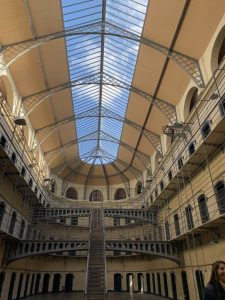Ireland Reflections 2020 – Dublin – Going to Jail & Guinness
As lots of good Sundays do, our Sunday morning in Dublin began with a drive. The group rode through Dublin’s Phoenix Park with the opportunity to view Áras an Uachtaráin – the President’s home–which was quite lovely. And then we went to visit the historic Kilmainham Goal.
 Kilmainham Gaol is a prison in Dublin that operated from 1796 to 1924. Austin Malinowski recalls that “once inside the walls, the beautifully constructed building changed into a cold harsh place that was no doubt meant to house prisoners. The building was freezing cold and consisted of brick and metal. The cells were small, as were the entryways (watch your head!)” He remarked “there was a clear focus on pounding the fear of God into these men, which is reflective of the Irish ties to Catholicism and Christianity in general. Faith seemed to be the focus even ahead of punishment, which was unusual to see for an American.” As we walked the halls of the prison, we were reminded of the people who made Ireland what it is today. Austin noted seeing “the cells of people like Countess Markievicz and Eamon de Valera, and I truly felt a sense of pride to be surrounded by the ghosts of these revolutionaries.”
Kilmainham Gaol is a prison in Dublin that operated from 1796 to 1924. Austin Malinowski recalls that “once inside the walls, the beautifully constructed building changed into a cold harsh place that was no doubt meant to house prisoners. The building was freezing cold and consisted of brick and metal. The cells were small, as were the entryways (watch your head!)” He remarked “there was a clear focus on pounding the fear of God into these men, which is reflective of the Irish ties to Catholicism and Christianity in general. Faith seemed to be the focus even ahead of punishment, which was unusual to see for an American.” As we walked the halls of the prison, we were reminded of the people who made Ireland what it is today. Austin noted seeing “the cells of people like Countess Markievicz and Eamon de Valera, and I truly felt a sense of pride to be surrounded by the ghosts of these revolutionaries.”
Student Jordyn Janikowski remarked that “in addition to many well-known political prisoners, the prison housed numerous average men, women, and children whose crimes ranged from theft to murder. Although it initially seemed obvious that all of the convicts that went to Kilmainham deserved to serve time for their crimes, some of the stories shed a different light on the prisoners.” She added that throughout the tour, “we heard stories of young children who were jailed for stealing food during times of famine, political prisoners who were brutally executed, and prisoners who had to perform hard labor for hours on end.” Jordyn was left with the lasting impression that “the tour of Kilmainham Gaol served as a reminder that all individuals, even prisoners, deserve basic human rights.”
Our day ended on a lighter note with the much-anticipated visit to the Guinness Storehouse.


 Interior of the museum
Interior of the museum